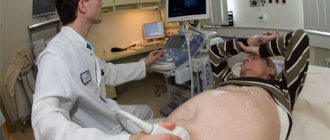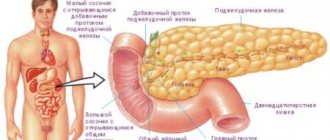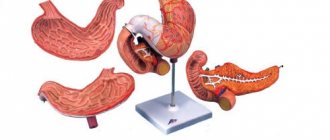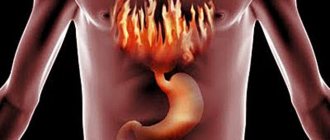A liver cyst is a cavity-like focal formation in the liver limited by a capsule and filled with fluid.
This disease is manifested by painful discomfort in the right hypochondrium, dyspeptic syndrome and nausea are possible. In order to know why a liver cyst is dangerous, you need to familiarize yourself with information on this pathology, including the causes, manifestations, diagnosis and possible methods of treating liver cysts. The liver can be called the main filter of the body, which, thanks to its continuous work, reduces the likelihood of harmful substances and toxins entering the human blood, which helps maintain our health. But, unfortunately, this organ is not immune from the occurrence of such a disease as a cyst. What is a cyst? This disease affects the mucous membrane of any organ.
What is a liver cyst
At its core, it is a tumor. It can be located in any part of the liver and affect its ligaments or surface. The neoplasm is considered benign. The cyst is a capsule ranging in size from a few millimeters to 25 centimeters, covered on the inside with columnar or cubic epithelium and filled with fluid.
If the tumor bleeds or becomes infected, this fluid will turn into a hemorrhagic or purulent mass.
As a rule, the disease is diagnosed between the ages of 35 and 55 years. Most often women suffer from it (3 to 5 times).
Types
Liver tumors are divided into parasitic and non-parasitic.
A parasitic cyst can be of two types:
- echinococcal. It is caused by tapeworms. In most cases, this type of cyst affects the right lobe of the organ.
- alveococcal. The neoplasm occurs due to parasitism of flatworms (cestodes) at the larval stage.
Non-parasitic cysts are divided into:
- true. This type is most often diagnosed. The formation of cysts is caused by abnormalities in the development of the bile ducts.
- false. The cyst appears as a result of rupture of the liver due to injury. The left lobe is most often affected.
Liver cysts can be single or multiple. The latter are formed in groups of 2 or more, affecting a third of one of the lobes of the organ.
Types of tumors of the left lobe of the liver
All benign tumors in the liver are divided into two large groups: parasitic cysts and non-parasitic ones. Cyst of the left lobe of the liver causes. Parasitic cystic bodies are not just benign tumors, but a kind of capsule in which the tapeworm larva develops and progresses. Such liver cysts appear mainly due to the pathological development of worms and their larvae in the body.
All parasitic tumors are divided into several groups:
Echinococcal tumor of the liver. Typically, such a cyst is localized on the right lobe of the liver, but it can also develop on its left part. A formation of this type is formed due to the attachment of a tapeworm to the liver body and its progression in the tissues of the organ. Alveococcal tumor of the first and second types. This type of cystic body develops due to the large distribution of cestode larvae in the body. The larvae attach to the liver tissues and begin their progression there, feeding on the tissues of the organ and producing toxic substances.
Benign tumors of the non-parasitic type are usually divided into acquired and congenital:
Acquired liver cysts appear, as a rule, due to mechanical damage to the organ, improper treatment, overdose or frequent use of hormonal drugs, as well as during traumatic surgery or after pregnancy. The capsules of non-parasitic tumors do not contain toxic microorganisms, but contain a clear or yellow liquid. Congenital benign tumors in the liver appear due to genetically determined degeneration of the bile ducts, due to which some parts of the canal may not be included in the general biliary system and become the site where the tumor subsequently develops.
It is important to note that the exact cause and prerequisites for the formation of a congenital tumor in the liver have not yet been clarified. Preliminary studies suggest that these pathological changes in the fetal body occur due to hormonal imbalances, and may also be the result of a failure of the genetic code.
Stages of development of cysts in the liver
The entire cycle, starting from the moment of infection, is divided into three periods:
- the first stage is the penetration of parasites into the blood and liver, and the formation of a cyst. At this stage, the immune system and the organ itself are still able to maintain the normal functioning of the body. As a rule, this stage lasts quite a long time and is asymptomatic.
- the second stage is when the tumor increases in size and forms a “leg” that falls into the abdominal cavity. The cyst reaches such a size that it begins to put pressure on the liver and cause pain to the person.
- the third stage is the rapid progression of educational growth. Accompanied by an inflammatory process and suppuration. At this stage, there is a high probability of liver rupture, but such cases are rare.
Cyst of the left lobe of the liver treatment
A good prognosis for the surgical approach is associated with the high ability to regenerate normal tissue of a given organ. In experiments and clinical studies, data were obtained indicating the possibility of restoring functional abilities with more than 60% excision of the gland. However, there are individual differences associated with genetic characteristics, the activity of cells in several branches of the immune system and hormonal regulation.
Cyst of the left lobe of the liver
However, surgery is recommended in only 6-10% of cases. There are still ongoing discussions about their necessity. They are definitely prescribed in case of infections (including helminthic infestations), an inflammatory process accompanied by an increase in temperature and the release of pus. In terms of surgical tactics, they try to use less damaging methods: drainage of the cyst cavity or laparoscopy under the control of precise diagnostic equipment.
Before surgery and after removal of tumors, it is recommended to monitor your diet. The diet does not include: fatty, spicy, salty foods. The consumption of toxic substances such as alcohol, tar contained in cigarettes and cigars, etc. is specifically prohibited.
It is recommended to include foods containing large amounts of fiber, pectins (fruits and vegetables), and sour milk derivatives.
Causes of liver cysts
Unfortunately, the causes of liver cysts have not been fully elucidated, but doctors and researchers are inclined to believe that a benign formation in the organ can occur in the following cases:
- blockage, inflammation and obstruction of the bile ducts of the liver (dominant version)
- hereditary transmission
- hormone therapy
- mechanical damage to the organ
- parasite infestation
For a cyst to form, one of the listed factors is sufficient. If the cause is helminths, a person can only get rid of them with the help of special means, but this will not stop the development of the cyst - serious treatment will be required.
Causes of the disease and its types
Varieties of benign tumors arise for various reasons, but in most cases the origin of non-parasitic tumors remains unclear.
Causes and types of cysts:
Echinococcosis of the liver on ultrasound
- A true simple cyst - the formation consists of bile-type epithelium - is the cause of the development of dilatation of isolated ducts. What causes this cyst is not clear, but a congenital predisposition is suspected. The species is prone to relapse;
- Polycystic disease is a genetically determined disease, which is often combined with polycystic kidney disease, which involves damage to an organ by several formations at the same time;
- Tumor-like cysts are formations with central tissue death, which are often mistaken for a true cyst. The cause is unknown. A tumor-like formation (cystadenoma) is considered a precancerous condition and has a high risk of degeneration into an oncological formation;
- Echinococcosis of the liver is a parasitic infection of the organ that a person can get through contact with pets, ignoring the rules of personal hygiene. Echinococcus larvae enter the liver and attach to the capillary network. Around them, a capsule (hydatid) appears from the germinal and chitinous layers and compacted fibrous tissue;
- An abscess is a cyst of bacterial (occurs when the rules of disinfection are violated during surgery, obstruction of the biliary tract and with ascending cholangitis) or amoebic (pathogen is dysenteric amoeba, which is infected by ingesting contaminated water or food) origin.
The etiology of the cyst and its type largely influence the choice of therapy and the development of complications, which is why differentiation of formations is so important at the diagnostic stage.
Liver cyst symptoms
If the tumor is single or has not reached a sufficient size to put pressure on the liver, then a person may not notice any symptoms of the disease. At this stage, a cyst can only be detected accidentally by ultrasound examination of the organ.
When the tumor grows to 7–8 centimeters, nonspecific signs begin to appear:
- general weakness
- belching, nausea, vomiting
- a feeling of heaviness and fullness under the ribs on the right side during physical activity or after eating
- intestinal upset and increased gas formation
- poor appetite, in some cases – refusal to eat
- increased sweating
with large cysts or multiple formations, the following are also possible:
- weight loss
- enlargement of the abdomen on one side (due to hepatomegaly - enlargement of the liver)
- jaundice and low-grade fever (occasionally)
It is important to know!
In cases of complications of the disease, hemorrhages, suppuration and perforation are likely. A person is bothered by attacks of abdominal pain. When the cyst is large, it can be felt through the abdominal wall upon palpation.
Symptoms
In the presence of small false cysts, a person often has no obvious symptoms, so detection of pathology often occurs during ultrasound examination (ultrasound) or computed tomography (CT) during diagnosis for another reason.
Symptoms usually occur when the cyst reaches a size of 7-8 cm in diameter, as well as the presence of multiple formations that occupy more than 20% of the parenchyma volume.
In this case, the patient may experience:
- a feeling of heaviness and/or dull pain in the epigastric region, in the right side (may increase with walking, physical activity);
- nausea and vomiting (usually after eating);
- decreased appetite;
- belching;
- flatulence;
- defecation disorder;
- weakness;
- increased sweating;
- dyspnea;
- increase in body temperature to subfebrile values;
- liver enlargement;
- jaundice;
- asymmetrical abdominal enlargement;
- weight loss.
This pathology can be combined with cystic formations of the bile ducts, cholelithiasis, polycystic kidney disease, pancreas and/or ovary disease, cirrhosis, etc.
Diagnostics
Liver cysts can be detected by ultrasound. In most cases this is what happens. If a tumor is suspected, the doctor must refer the patient for special studies of the organ. These include:
- echography – thanks to echo signals, it is possible to determine the tumor and the density of its contents
- Magnetic resonance diagnostics makes it possible to distinguish a cyst from a hemangioma. Laparoscopy will help to obtain a more accurate diagnosis.
- CT scan
- angiography of the celiac axis
- puncture of the cyst, cytological and bacteriological examination of samples taken
- scintigraphy - a study based on the introduction of radioactive isotopes to visualize disorders
- serological blood test to exclude the parasitic origin of the cyst
Treatment
Today, treatment for liver cysts consists of removing the tumor (except when its size is no more than 3 centimeters). Surgeons use 2 techniques:
- palliative, which involves opening the tumor and emptying it, suturing the wound with the edges of the cyst and cytogastroanastomosis (connection of vessels, veins, ducts)
- conditionally radical, including elimination of the diseased part of the liver, enucleation of the cyst and excision of its wall
After the operation, the patient begins taking medications to restore the liver. In addition, treatment must include drugs to maintain the body’s protective functions. Deviation from the medication schedule and violation of the recommendations of the attending physician can lead to disruption of the functioning of not only the liver, but also other organs.
Classification
There are certain types of cysts in the liver. The first of them implies division depending on the etiological factor. Thus, such neoplasms are divided into:
- parasitic;
- non-parasitic.
Classification of liver cysts
Neoplasms of parasitic nature are divided into:
- hydatid cyst of the liver - develops due to the penetration of tapeworms into the human body, which invade the organ and multiply in it;
- alveococcal liver cyst - is a consequence of alveococcal parasitism.
Non-parasitic liver tumors have their own classification and are:
- congenital or true - most often diagnosed. It is formed against the background of abnormalities of the bile ducts. This variety is considered harmless to humans, but only if growth dynamics are not observed;
- acquired or false - often the result of liver injury.
A true cyst in the liver has the following division:
- solitary - the cyst is usually determined in the right lobe of the liver, namely in its lower part. It differs in that it has a leg, due to which it hangs into the abdominal cavity;
- polycystic disease - this type of disease is a consequence of a genetic mutation. These neoplasms are diffusely distributed throughout the liver and are always found in its upper layers. Such cysts increase in size throughout a person’s life;
- Cystic fibrosis is the most severe form of the disease and poses a danger to the life of a newborn. This is due to the fact that it affects not only the liver, but also its main vein, the portal vein, and is also prone to growing into many bile microcysts.
Based on the number of tumors in the liver, cysts are divided into single and multiple, and based on the presence of complications - into complicated and uncomplicated.
The latest classification of the disease - depending on the size of the cyst, they are:
- small - volumes do not exceed one centimeter;
- medium - sizes vary from one to three centimeters;
- large - reach ten centimeters;
- gigantic - grow 25 centimeters or more.
Folk remedies
Decoctions and infusions from medicinal plants can provide powerful support to the body in the fight against tumors and in the restoration of the liver after surgery. But their uncontrolled use can be disastrous, so treatment of liver cysts with herbs, their dosage and frequency of administration must be agreed with a doctor.
The substances contained in the following plants work effectively:
- burdock (root and juice)
- celandine (juice)
- pine nut (shell)
- milk thistle
- yarrow
- cleavers
- mullein
- elecampane
In addition to herbal infusions, the use of quail eggs, as well as kombucha tincture, gives a positive result
Consequences of a liver cyst
The likelihood of relapses after removal of a solitary cyst is low, but from now on the patient must follow a diet and visit a gastroenterologist-hepatologist for follow-up examinations.
If a puncture was performed in the case of such a cyst, then there is a possibility of re-formation of the tumor both immediately after surgery and after a long period of time.
If the liver is not treated, the growth of tumor tissue can lead to:
- cyst rupture
- inflammatory process and the appearance of pus
- cyst bleeding
- entry of helminths into the abdominal cavity
- liver failure
The latter complication most often ends in death.
How is liver cyst treated?
- First of all, it is recommended to adhere to proper nutrition. Take food only in small portions, roughly dividing the intake into 5-6 times a day. Take only at the same time, have dinner a couple of hours before your night's rest.
- The diet should include foods with nutritional components, for example, foods high in vitamin C and E and minerals.
- Avoid fried and spicy foods; steam and stewed foods should be included in your diet.
- Liquid is an important component of the diet; consume at least 2.5 liters.
It should be noted right away that if the patient is asymptomatic, the cyst does not exceed 3 cm in diameter. Then the patient necessarily needs dynamic observation by a gastroenterologist (hepatologist). The surgeon will help you get rid of the cyst through surgery.
Indications for surgery:
- Heavy bleeding;
- When a cyst ruptures;
- Attachment of infection;
- Impaired flow of bile;
- Portal hypertension.
Surgery can be performed in several ways. The most common method is radical. In this case, the surgeon performs organ resection, immediately followed by transplantation.
The conditionally radical method of surgical intervention is done by enucleating the tumor. It has become important to use the laparoscopy method.
The palliative method is based on puncture of the cyst followed by aspiration. This method is used for cysts no larger than 6 cm.
In addition to the surgical method, symptomatic treatment is prescribed. Doctors prescribe painkillers, anti-inflammatory drugs and hepatoprotectors that improve intestinal function.
Traditional methods of treatment are prescribed as additional therapy. It is prohibited to use folk recipes on your own, as there is a risk of complications. Alcohol tincture of celandine and burdock juice have proven themselves to be effective for this illness.
In any case, to prevent complications, you should consult a doctor at the first signs. If the cyst is asymptomatic, then you should undergo preventive examinations in a timely manner.









